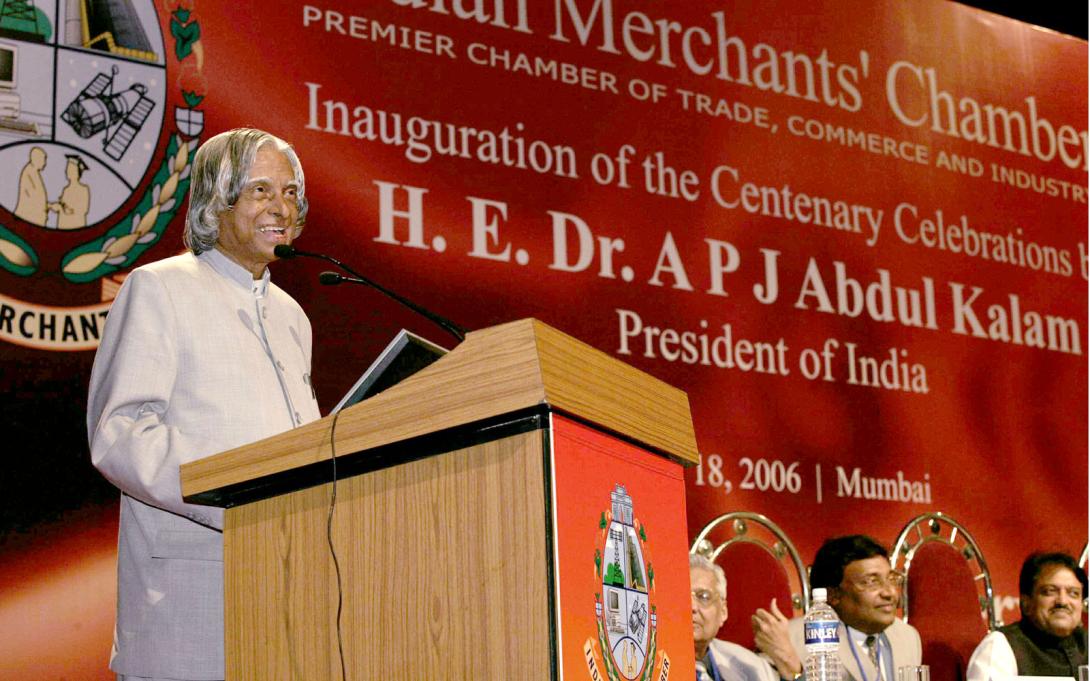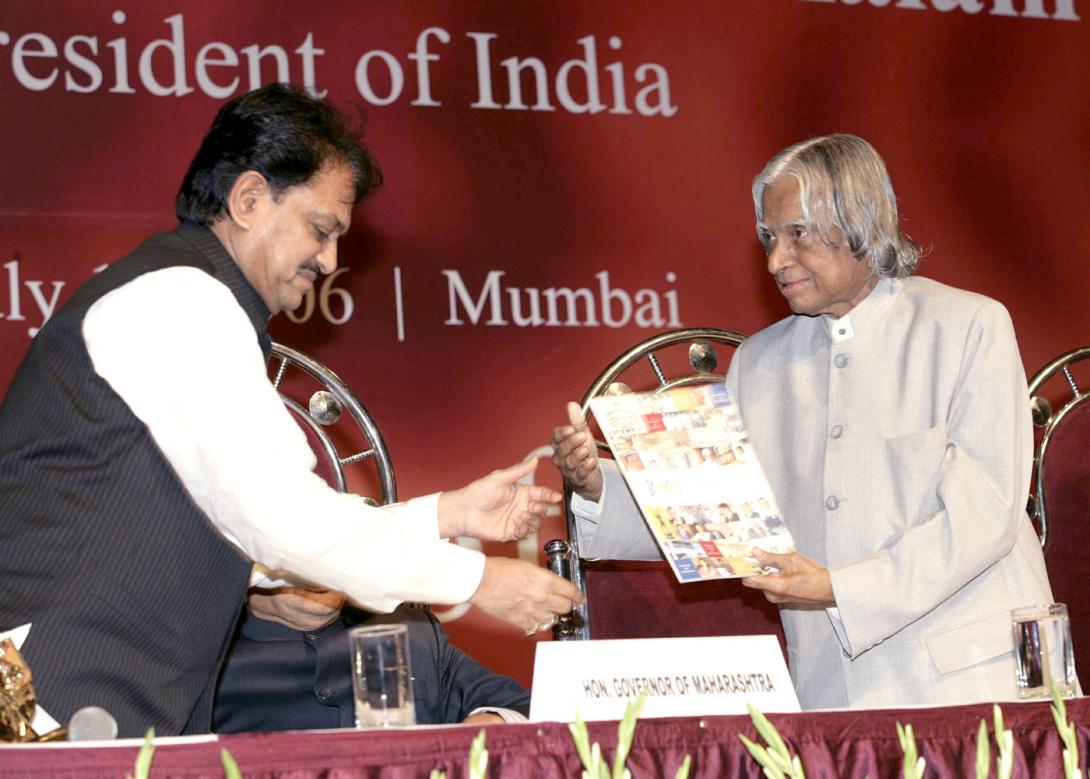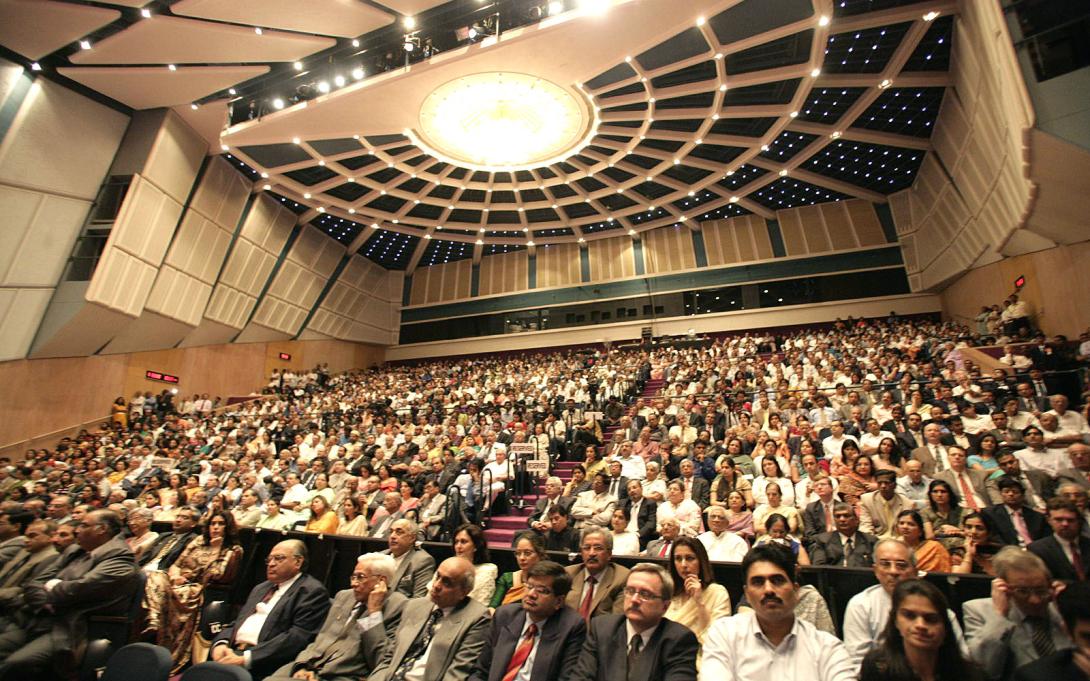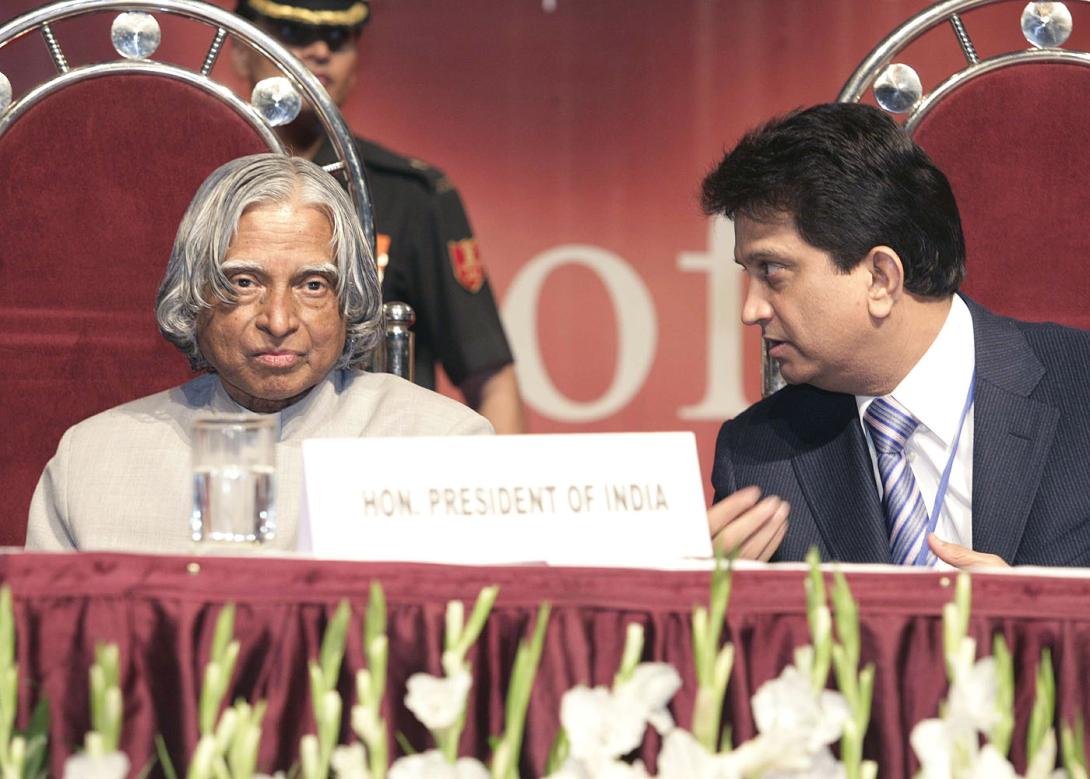Address at the Centenary Celebrations of the Indian Merchants' Chamber 2006-07, Mumbai
Mumbai : 18-07-2006
Technology, Industry and Commerce
"The competitiveness is powered by knowledge"
I am indeed delighted to participate in the Centenary Celebrations of the Indian Merchants? Chamber (IMC). My greetings to the members of the Indian Merchants? Chamber, distinguished guests and participants of this event. I studied the type of membership of IMC and I find that there are 250 institutional members apart from 5000 individual members spread in different parts of the country. I take this opportunity to congratulate all the members of IMC present and past who have contributed during various phases of the growth of IMC in promoting excellence in commerce and industry during the last hundred years. Friends, I am very happy to flag off the Centenary Celebrations of Indian Merchants? Chamber. The IMC indeed has nurtured and grown industrialists, businessmen and entrepreneurs. On this occasion, I have selected the topic for discussion "Technology, Industry and Commerce". First of all, let me talk about ambience in the nation.
Ambience in the Nation
In the Indian history, very rarely our nation has come across a situation, all at a time, an ascending economic trajectory, continuously rising foreign exchange reserve, global recognition of the technological competence, energy of 540 million youth, umbilical connectivities of 20 million people of Indian origin in various parts of the planet, and the interest shown by many developed countries to invest in our engineers and scientists including setting up of new R&D centers in our country. Above all, India as the largest democracy in the world, has a reputation for its democracy and for providing leadership for the one billion people with multi-cultural, multi-language and multi-religious backgrounds. And also our technological competence and value systems with civilizational heritage are highly respected. Also, foreign investors find investing in India attractive. But we have a long way to go. We have to streamline our procedures and work towards a single window clearance system to attract foreign investment in a big way. Indians are also investing abroad and open new business ventures. The Government is committed to economic development by ensuring growth rate of 8% to 10% annually and maintaining it for a decade, for enhancing the welfare of the farmers and workers by unleashing the creativity of the entrepreneurs, business persons, scientists, engineers, youth and other productive forces of the society. Let us look at our national development challenges. (i) 40 to 50 million people need productive employment (ii) 220 million people live below poverty line (iii) 600 thousand villages where our 700 million people live, need physical, electronic and knowledge connectivity leading to economic connectivity. To meet the challenges, I will be discussing our national mission and PURA (Providing Urban Amenities in Rural Areas), in conjunction with Bharat Nirman Programme.
When I study the sectoral growth rate of our economy, I find that both manufacturing and services sectors are showing robust growth whereas the agriculture is substantially lagging behind. To raise the agricultural growth to over 4% which is vital for increasing the overall GDP growth to 10% we may have to resort to farm management based approach which will provide the newer technologies to the farming community. Also, we have to invest in agro-food processing and agro- industries so that the farmer gets the benefit for higher income from his farm through value addition to his produce. A study of the composition of State Bank of India loan book indicates that the loan for agriculture is static at 10%. Hence, there is a need to increase the loan allocation to the agricultural sector along with technological and managerial inputs which will enable us to enhance the growth of this sector over 4% in a time bound manner. Simultaneously, the banks have to become pro-active venture capitalists who can take calculated risks and facilitate development of innovative products suiting to rural needs through creative entrepreneurs. This shift in emphasis is essential for enabling faster growth of Indian economy. For promoting faster growth we need innovation.
Innovation is the capital
I was studying the Global Competitiveness Report for the year 2005-06. There I find in terms of Growth Competitive Index ranking US is ranked 2, Singapore 6, South Africa 42, China 49 and India 50. I am glad to find that India has moved up in competitiveness to 50 from 56. Growth competitiveness is determined by the innovative ability of an organization. This innovation arises from institutional initiative and the R & D productivity of the firm, shaped by policies and nature of local institutions. National innovative capacity has to be the country?s important potential to reinforce both political and economic entity with commercially relevant competitive products. This capacity is distinct from purely scientific or technical achievements and focuses on the economic application of new technology. When I am in the midst of leaders from many areas of business and industry, I would like to pose a challenge to all of you to work collectively to bring the growth competitiveness index of India to less than ten. Can we do it? If we achieve this we have realized the goal of making India into a developed nation very fast. Now I would like to discuss about law of development.
Law of development: Competitiveness
Last two years, I was studying the development patterns and the dynamics of connectivity between nations, especially in trade and business. As you all know the world has few developed countries and many developing countries. What is the dynamics between them and what connects them? Developed country has to market their products in a competitive way to different countries to remain as developed country. The developing country to get transformed into developed country; they too have to market their products to other countries in a competitive way. Competitiveness has three dimensions: quality of the product, cost effectiveness and supply in time. Indeed this dynamics of competitiveness in marketing of products by developing and developed countries is called the law of development. For making the country competitive we have to make our rural areas competitive. This can be achieved through PURA since India has 600 thousand villages where 700 million people live.
Hence, one of the important components of national development is the creation of PURAs (Providing Urban Amenities in Rural Areas). PURA envisages integrated connectivities to bring prosperity to rural India. These are - physical connectivity of the village clusters through quality roads and transport; electronic connectivity through tele-communication with high bandwidth fiber optic cables reaching the rural areas from urban cities and through internet kiosks; and knowledge connectivity through education, vocational training for farmers, artisans and craftsmen and entrepreneurship programmes. These three connectives will lead to economic connectivity through starting of enterprises with the help of banks, micro credits and marketing of the products.
Each PURA cluster will connect about 20 villages depending upon the region and population and will cost about Rs.100 crores. After initial short-term employment during construction etc., we have to plan for initiating actions for providing regular employment and self employment opportunities in nationally and internationally competitive enterprises in agro processing, manufacturing and services sectors for about 3,000 people. If the industrial/business parks are marketed well, they can generate employment opportunities in support sector for about 10,000 people for a village complex having 30,000 people. This will provide sustainable economy for the rural sector. The total number of PURAs for the whole country will be around 7,000.
We must realize Bharat Nirman Programme, with an allocation of Rs. 1,74,000 crores for the duration of four years and Rural Employment Guarantee Scheme for 200 districts of the nation ensures availability of adequate funding support for Rural Development Missions.
In this national mission, IMC can promote entrepreneurs in the rural areas particularly in setting up of agro-food processing industries as co-operative institutions based on the core competence of the region. IMC can also promote venture capital enterprises for generating the rural technology needed for the innovative rural enterprises. This will facilitate creation of large scale employment in the rural areas leading to the removal of urban-rural divide. The small and medium scale industries have acquired knowledge and experience in running enterprises in our rural areas. They can be one of the candidates for taking up the leadership in establishing PURAs in their areas.
Small Scale Industries (SSI)
SSI Sector in India creates large employment opportunities in the country. The product groups where the SSI sector dominates in exports are sports goods, readymade garments, woolen garments and knitwear, plastic products, processed food and leather products. The strategy for enhancing the exports of goods and services from SSI Sector has to be based on technology upgradation, value addition techniques, credit support and export marketing zones. Reviving small scale industries is an important agenda for the Government. Particularly IMC should take the lead in identifying critical areas that need governmental and technological inputs based on national and international market survey. Emphasis should be on full activation of all SSIs which need technological and credit support.
Local Outsourcing: Competitiveness comes out of large quantity needs, cost effectiveness, quality, and marketing capability, as discussed. Today a new situation has come, where MNCs are coming to our country for the availability of high technical man power and lower cost of production, in software or hardware or combination of both. Hence, Indian industries have to take this potential as an advantage. Also I would like to suggest a thought in out-sourcing and sub-contracting methods. Here particularly IMC may aim at realizing component level outsourcing to cottage industries and also to homes wherever applicable in the rural areas. Now, I would like to discuss about textile industry which has the large potential for providing employment opportunities and earning foreign exchange.
Textile industry
Textile industry is very important for the Indian economy. The basic raw material is cotton or synthetic yarn. India is the third largest producer of cotton in the world. However, compared to the world average of 700 kg. of seed cotton per acre, we produce only 350 kg. of seed cotton per acre. It is indeed a technological concern for the nation. Some of the industries have adopted certain villages in Punjab, which has brought out a cooperative movement of the farmers, scientists, trainers and the industry and launched for cultivating cotton in over 1200 acres. A training programme was launched for farmers starting with soil characterization, matching the cottonseed to soil, water and fertilizer management.
The project resulted in increasing the average seed cotton yield of the village from 450 KG per acre to 950 KG per acre. This led to the seven-fold increase in net return per acre, due to considerable reduction in input costs. It is worth noting that in this case the yield is above the world average. This model has already been replicated in twenty five villages in Punjab. The revenue increase due to higher production in these twenty-five villages is around Rs. 20 crore. Certainly Maharashtra can emulate this model. India can definitely produce 25% of the total world production of quality cotton compared to the existing 12% leading to revenue of over Rs. 25000 crores a year for the nation.
I would like to link cotton production to garment export business, which is a low investment and large volume employment generator. India is presently, exporting around eight billion dollars worth of garments, whereas we can increase the production and export of garments to 18 to 20 billion dollars within the next five years. This will enable, generation of employment in general and in rural areas in particular. By tripling the export of apparels, we can add more than 5 million direct jobs and 7 million indirect jobs in allied sector. Concerted effort is needed in Cotton research, synthetic yarn, technology generation, transfer of technology, modernization and upgrading of ginning and pressing factories and aggressive marketing strategy. IMC can be a facilitator for enhancing the apparel export of the nation.
Let me now discuss the vision and the growth of Indian Pharma industry.
Pharma Vision
The global production of pharmaceuticals, branded and generics put together is of the order of $550 billion. The Indian Pharma industry at present has a turnover of $12.5 billion of generics for domestic and export markets against the production of $78 billion worth of generics in the world. Pharma Council has evolved the Pharma Vision 2020; I have suggested that Pharma community should identify all missions which will make India the leader in drug production. We should set a target of producing 40% of world generics production. India has got a core competence of producing cost effective and quality Pharma products. Recently, I visited one of the Biotechnology Institutions at Bangalore. I would like to share the development of an important drug for cancer treatment.
Antibody based drug for Cancer
The first antibody product for cancer has been indigenously developed by Biocon India Ltd.? a pioneering biotechnology company engaged in the manufacture of bio-molecules for healthcare, in collaboration with CIMAB, a Cuban Research Institute. The product is Epi-dermal Growth Factor Receptor anta-go-nist targeting Mono-clonal Antibody. The drug is called BIOMAb-EGFR. Mono-clonal antibodies (MAb) are proteins produced from specially engineered cells grown under controlled conditions in specially built bio-reactors. BIOMAb ? EGFR was designed to specifically bind to a cell-surface marker called Epi-dermal Growth Factor Receptor (EGFR) that is over expressed in many types of Cancer. Upon binding the EGFR, BIOMAb blocks the proliferation of the cancer cells by interfering with internal cell-signaling pathways. In addition, the Antibody mobilizes the body?s immune system and targets the cancer cells. Over a period of four years, the scientists have successfully cloned and expressed a humanized antibody in mam-ma-lian cells which has been successfully scaled up to pilot plant size and is ready for commercial production. Extensive clinical trials over two years have been conducted in multiple cancer centers in India to evaluate its safety and efficacy in the treatment of head and neck cancers. Head and neck cancers account for 37% of the cancer population in the country, largely related to tobacco-consumption. The antibody will also be effective in several other cancers that express EGFR including Colo-rectal, Pancreatic, Meta-static Breast, Non Small Cell Lung tumor and Brain Cancers. This is the first indigenously developed Mono-clonal antibody in the country which will benefit thousands of cancer patients that express EGFR in their tumors. Although a large number of Mono-clonal Antibodies have been introduced into the country by Multi-national Pharmaceutical companies, they are beyond the reach of the majority of cancer patients due to their prohibitive cost. The present indigenous development of mono-clonal antibodies will be accessible and affordable to a larger number of Indian patients. Biocon joins the exclusive league of mono-clonal antibody developers and will become a key player in this segment in the coming years. These antibodies have multiple potential applications including nuclear imaging, surgical mapping and direct therapy in multiple settings. Another area I would like to discuss is global human resource.
Global Human Resource leading to Knowledge society
In the coming years I visualize larger participation of Maharashtra in the IT, ITES and BPO sectors. As per NASSCOM McKinsey Report-2005, the requirement of knowledge manpower in the IT sector by 2010 is expected to be over 9 million and in the support sector such as transportation, construction and retailing will be around 6.5 million. I visualize at least 1 million direct jobs on IT, ITES and BPO sectors and another 1 million jobs in construction, retail and transportation being occupied by Maharashtra?s youth. For this, there is a need to carry out state-of-the-art, skill oriented sectoral training of the youth who have the necessary aptitude for such tasks. This is an important mission to be carried out by the IMC in participation with NASSCOM and leading BPO companies located in Mumbai, Pune and other tier-2 cities of Maharashtra. I have seen a working BPO in the rural environment near Bhimavaram, in Byrraju PURA, which has enabled reverse migration of education from Hyderabad. This model can be replicated in many other 2-tier cities in the PURA clusters of Maharashtra.
Let us think together, what are the types of enriched partnerships possible between IMC and Maharashtra knowledge industry. Two distinct areas can be identified. They are, (i) Transforming India into knowledge society with innovation as the thrust area influencing the information society, industrial society and agricultural society. (ii) As you are aware India has 540 million youth below 25 years which is an important asset for the planet Earth. This dynamic resource will have two components. One, at the secondary education level supplemented with high quality vocational skills and the other at the university level. Knowledge workers will come out of this Global Human Resource Cadre. Definitely, IMC can participate in the evolution of trained human cadre.
Economic development and prosperity
Now I would like to talk to you about the growth of the economic development and prosperity.
- Nations Economic development is powered by competitiveness.
- The competitiveness is powered by knowledge power.
- The knowledge power is powered by Technology and innovation.
- The Technology and innovation is powered by resource investment.
- The Resource investment is powered by revenue and return on Investment.
- The Revenue is powered by Volume and repeat sales through customer loyalty.
- The customer loyalty is powered by Quality and value of products.
- Quality and value of products is powered by Employee Productivity and innovation.
- The Employee Productivity is powered by Employee Loyalty, employee satisfaction and working environment.
- The Working Environment is powered by management stewardship.
- Management stewardship is powered by Creative leadership.
Conclusion: Creative Leadership
For success in all projects we need creative leaders. Creative leadership means exercising the vision to change the traditional role from the commander to the coach, manager to mentor, from director to delegator and from one who demands respect to one who facilitates self respect. For a prosperous and developed India, the important thrust will be on the growth in the number of creative leaders and innovative organizations who can create wealth through dedicated entrepreneurship.
My greetings to all the members of IMC during their centenary celebrations and my best wishes in their mission of making the Indian industry nationally and internationally competitive.
May God bless you.






